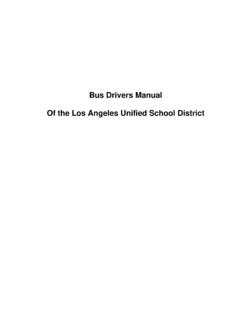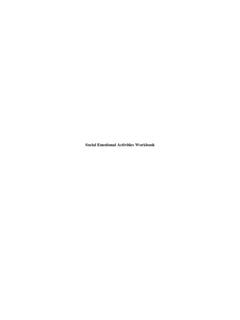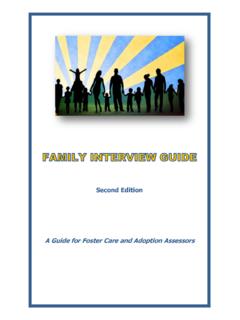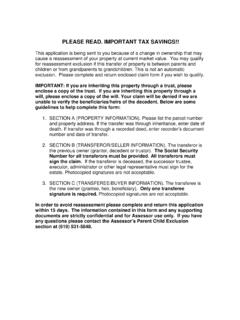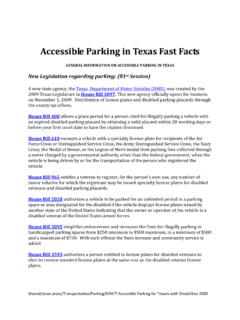Transcription of OPERATIONAL DEFINITIONS OF COMMONLY OCCURRING …
1 OPERATIONAL DEFINITIONS OF COMMONLY OCCURRING BEHAVIORS Note: These DEFINITIONS may not be suitable for every case. It is the responsibility of the assessor to determine appropriate 0perational DEFINITIONS . CRYING, SCREAMING AND TANTRUMS Crying only o Crying is defined as the occurrence of vocalization (sounds or words) accompanied by facial contraction with or without tears for any period of time. Screaming only o Screaming is defined as the occurrence of vocalizations at a volume above normal conversational level for any period of time. Lying on the floor o Lying on the floor when doing so is not part of the class activity. If there are combinations of behaviors listed above use the individual DEFINITIONS under the behavior of tantrum. For example: Tantrum is defined as any occurrence of the following for any period of time: Lying on the floor when doing so is not part of the class activity Crying: any vocalizations (sounds or words) accompanied by facial contraction with and without tears for any period of time.
2 Screaming: occurrence of vocalizations above normal conversational volume for any period of time DISRUPTIVE, OFF-TASK AND ON-TASK BEHAVIORS Disruptive Behaviors o Disruptive behaviors are defined as any occurrence of displacing desks, chairs, objects, or work material from their original location without permission. Off-Task Behaviors o Off task behaviors are defined as engagement in any tasks other than the assigned task or ongoing activity ( , looking around the room, playing with items, talking, head on the desk) for more than x seconds. (Indicate time.) Academic Engagement o Academic Engagement is defined as engagement in any behavior for any period of time that matches the ongoing classroom instruction ( , class is writing, the target student is writing). ELOPEMENT (LEAVING SEAT, CLASSROOM OR SCHOOL GROUNDS WITHOUT PERMISSION) Leaving the seat or carpet area without permission o Elopement is defined as being more than x feet away from a designated area (seat or rug) without adult permission for any duration of time.
3 (Indicate distance.) Leaving the classroom without permission o Elopement from classroom is defined as being outside the class without adult permission for any duration of time. Leaving the school grounds without permission o Elopement from school grounds is defined being outside the school gates without adult permission for any duration of time. Running away from adults o Running away from an adult is defined as any period of time being more than x feet away from an adult without permission. (Indicate distance.) OPERATIONAL DEFINITIONS OF COMMONLY OCCURRING BEHAVIORS Note: These DEFINITIONS may not be suitable for every case. It is the responsibility of the assessor to determine appropriate OPERATIONAL DEFINITIONS . INAPPROPRIATE AND APPROPRIATE PLAY Appropriate play o Appropriate play is defined as the use of leisure items or toys in the manner for which they were intended, where one response leads to or proceeds from another in the accomplishment of some project or activity.
4 Inappropriate play o Inappropriate play is defined as behavior that is not within the context of the ongoing activity and/or the misuse of leisure items ( , throwing toys not intended for throwing, jumping on furniture, flapping a doll s arms, or breaking toys). Reciprocal play o Reciprocal play is defined as engagement in play with a peer which may include use of a toy or item in the manner for which it was intended. Sharing or cooperating o Sharing or cooperating is defined as vocal or gestural interaction which can occur in one of three conditions: 1. The child offers to share or trade materials with a peer ( , offering a crayon). 2. The child simultaneously uses the same material as his or her peer in working towards a common goal ( , coloring on the same piece of paper), or in turn taking ( , playing on a slide). 3. The child is involved in cooperative play with peers ( , playing a game of cards).
5 NON-COMPLIANCE AND COMPLIANCE Non-compliance o Non-compliance is defined as any occurrence of saying no , I don t want to , I won t do it or not now to any academic or non-academic request. o Non-compliance is defined as any response that does not match the delivered instruction within x seconds from the time the instruction was delivered ( , was asked to write and after 10 seconds was speaking with a peer). (Indicate time.) Compliance o Compliance is defined as engaging in a response that matches the delivered instruction within x seconds from the time the instruction was given and completing the request. (Indicate time.) PROPERTY DESTRUCTION Property destruction o Property destruction is defined as damaging personal or public property ( , breaking an object into two or more pieces, using an object to break other objects, ripping objects or parts of objects from walls, floors, or furniture, and denting cars, objects, or walls.)
6 Episodes of property destruction are scored as a single response unless at least x ( , 30 or 60) seconds has elapsed since the last break, rip, or dent. PHYSICAL AGGRESSION Biting o Biting is defined as any occurrence of opening and closing of the jaw with upper and/or lower teeth making contact with any part of a person s body (except kissing). OPERATIONAL DEFINITIONS OF COMMONLY OCCURRING BEHAVIORS Note: These DEFINITIONS may not be suitable for every case. It is the responsibility of the assessor to determine appropriate OPERATIONAL DEFINITIONS . Hitting o Hitting is defined as any occurrence of making contact with any part of another person s body with an open or closed hand from a distance of six inches or more. Kicking o Kicking is defined as any occurrence of making contact with any part of another person s body using a foot from a distance of six inches or more. o Propelling objects at least one foot from their original location by movement of foot or leg in the direction of another person.
7 Pinching o Pinching is defined as any occurrence of making contact with another person s skin with fingers shaped like forceps. Scratching o Scratching is defined as any occurrence of digging the fingernails into another person s skin and/or moving them across another person s skin or clothing. Spitting o Spitting is defined as any occurrence of projecting matter or objects from the mouth, does not include drooling or saliva leaving the mouth during the course of eating. Throwing objects o Propelling objects at least one foot from their original location by movement of hand or arm. o If there are combinations of the behaviors listed above use the individual DEFINITIONS under the behavior of aggression. For example: Aggression is defined as any occurrence of any of the following: Pinching is defined as making contact with another person s skin with fingers shaped like forceps.
8 Biting is defined as opening and closing of jaw with upper and lower teeth making contact with any part of a person s body part (except kissing). Scratching is defined as digging in the fingernails onto another person s skin and/or moving them across another person s skin or clothing. REPETITIVE AND STEREOTYPICAL BEHAVIORS Jumping o Jumping is defined as 2 or more consecutive occurrences of both feet separating from the floor from an upright position. Rocking o Rocking is defined as 2 or more consecutive occurrences of back and forth and/or side to side movement of the upper body. Hand flapping (Repetitive hand movement) o Repetitive hand movements are defined as 2 or more consecutive occurrences of up and down and/or side to side motion of hands. Spinning o Spinning is defined as any occurrence of the body turning 360 degrees. Gazing o Gazing is defined as eyes focused on one point in space or stimuli ( , staring into windows, mirrors, lights, objects or on to certain points in the environment) for x seconds or more.
9 (Indicate time.) Repetitive watching of video clips or listening to music o Repetitive watching of videos or listening to music is defined as 3 or more consecutive occurrences of rewinding video clip to the same point. OPERATIONAL DEFINITIONS OF COMMONLY OCCURRING BEHAVIORS Note: These DEFINITIONS may not be suitable for every case. It is the responsibility of the assessor to determine appropriate OPERATIONAL DEFINITIONS . Repetitive vocalizations o Repetitive vocalizations are defined as any vocalization ( , sounds, words, phrases, and/or sentences) unrelated to the present situation ( , vocalizing without being asked a question) or nonfunctional speech. Note: Any behavior can be a repetitive behavior if it is repeated without variation, though it may not be listed here. VERBAL OUTBURSTS Yelling with use of profanity o Yelling is defined as any vocalization that is at a volume above normal conversational level for given setting and includes using profanity or language that is not appropriate for the setting ( , calling a peer the B word or stupid and so on).
10 Yelling without use of profanity o Yelling is defined as any vocalization that is above normal conversational level for given setting without permission. Verbal aggression o Verbal aggression is defined as any threat or comment directed towards others that indicates any form of physical harm to another person ( , I am going to throw you down the stairs!"). Use of profanity o Profanity is defined as any vocalization consisting of or including vulgarities ( , racial slurs, sexually overt comments) or expletives ( the F-word, S-word, B-word) or words that are not age-appropriate ( , for younger students words such as stupid, idiot, poopyhead). Appropriate vocalizations o Appropriate vocalizations are defined as any contextually appropriate vocalizations that include requests for attention, breaks, or tangible activities, and/or conversational exchange. This space intentionally left blank.
